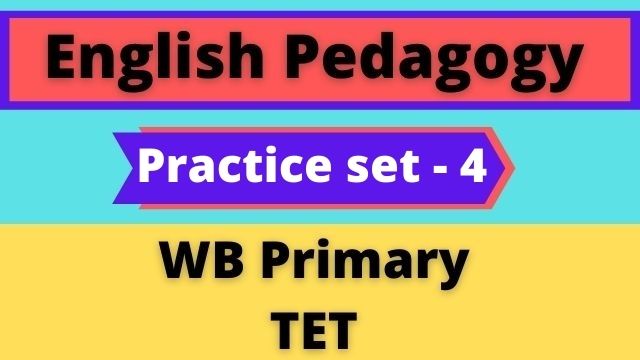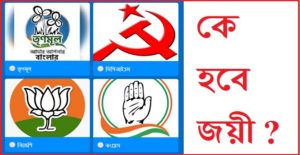English Pedagogy – WB Primary TET Practice Set-4
- Progress from generalization to specific example is
A.deductive
B.inductive
C.incidental
D.remedial
Ans. A.deductive
- The founder of structural grammar was
A.Nesfield
B.Chapman
C.Chomskey
D.C.C. Fries
Ans. D.C.C. Fries
- Inductive method proceeds from
A.known to unknown
B.simple to complex
C.complex to simple
D.both a & b
Ans. D.both a & b
- In the traditional method of teaching grammar
A.language fluency is to be required
B.black board are essential
C.text book is must
D.all the above
Ans. C.text book is must
- Language acquisition occurs only when
A.the child learns the rules of grammar
B.the child is exposed to the language
C.tha child memorises the lesson
D.the child is given a reward
Ans. B.the child is exposed to the language
- Method is teaching grammar is
A.deductive
B.inductive
C.incidental
D.all the above
Ans. D.all the above
- Study of correct spelling is known as
A.syntax
B.semantics
C.morphology
D.orthography
Ans. D.orthography
- Structural approach in english stresses on
A.speech
B.conversation
C.listening skill
D.reading skill
Ans. A.speech
- Syntax is the study of
A.grammatical arrangement of words
B.accuracy of pronunciation
C.correct use of words
D.none of these
Ans. A.grammatical arrangement of words
- The curriculum should ideally
A.connect knowledge outside
B.do away with assessment
C.provide overall development of children
D.address social need
Ans. A.connect knowledge outside
- The study of the structure of the language is called
A.linguistics
B.morphologh
C.etymology
D.axiology
Ans. B.morphologh
- Students in FCA are allowed
A.no freedom
B.to learn the rules first
C.much freedom
D.to learn according to their own will
Ans. C.much freedom
- A language is best learnt by
A.initiation
B.inhibition
C.imitation
D.intimation
Ans. C.imitation
- At the initial stage FCA focuses on
A.listening
B.speaking
C.writing
D.listening and speaking
Ans. D.listening and speaking
- Learning a language requires
A.an inborn capacity
B.an inmate capacity
C.an external stimulus
D.none of the above
Ans. B.an inmate capacity
- In grammar translation method little importance is given to
A.vocabulary
B.punctuation
C.spelling
D.pronunciation
Ans. D.pronunciation
- Remedial teaching is needed
A.to test learners periodically
B.to help students pass the exam
C.to address gaps in learning
D.to help bright students to excel
Ans. C.to address gaps in learning
- The direct method was popularized by
A.the international phonetic association
B.the inter international semantic association
C.german linguists
D.american linguists
Ans. A.the international phonetic association
- Noise in to classroom indicates
A.indiscipline of the learners
B.incompetence of the teacher
C.constructive activities of the learners
D.disinterested learners
Ans. B.incompetence of the teacher
- Direct method prohibits
A.communicability
B.fluency
C.vocabulary
D.memorization
Ans. D.memorization
- Every language is a system of
A.some words
B.some punctuation Marks
C.some symbols
D.alphabet
Ans.C.some symbols
- Direct method is an attempt to
A.minimize the use of mother tongue
B.activate the skill of writing
C.minimize errors in vocabulary
D.all the above
Ans. A.minimize the use of mother tongue
- Teaching aids for foreign language teaching are
A.not needed
B.not effective
C.essesntial
D.none of the above
Ans. C.essesntial
- The main techniques of direct method is
A.conversation
B.look and say
C.leadership and guidance
D.all the above
Ans. D.all the above
- The best method of teaching grammar is
A.direct method
B.indirect method
C.both a & b
D.practical method
Ans. D.practical method
- Learning take place when
A.a student listens to the teacher
B.a student obeys the teacher
C.a student gets the correct response from the teacher
D.all the above
Ans. C.a student gets the correct response from the teacher
- ‘A large class’ in the context of reaching means
A.a big classroom
B.a class with many students
C.a class where all the students of the school assemble
D.none of these
Ans. B.a class with many students
- A language teacher must
A.an introvert
B.an extrovert
C.an expensive
D.none of the above
Ans. C.an expensive
- The role of grammar in speaking a language is
A.not at all important
B.most important
C.liberal
D.none of these
Ans. C.liberal
- A language teacher must have
A.charming personality
B.good voice modulation
C.sense of coordination
D.good command over language
Ans. D.good command over language
- A poem can be best taught by
A.making the students recite it
B.oral language drill
C.group discussion
D.reciation and then explanation
Ans. D.reciation and then explanation
- Before starting a new lesson, teacher must
A.test the previous knowledge
B.check the motivational level
C.prepares an exposition and orientation
D.all the above
Ans. D.all the above
- Comprehensive evaluation refers to assessment of
A.curricular activities
B.co curricular activities
C.summrative assessment texts
D. Both a & b
Ans. D. Both a & b
- In speaking a language the role of grammar is
A.most important
B.not at all important
C.liberal
D.none of these
Ans. C.liberal
- An effective language classroom should provide scope for
A.relaxation
B.interaction
C.imitation
D.evaluation
Ans. B.interaction
- Teaching a second language must
A.allow use of mother tongue
B.avoid use of mother tongue
C.ban using mother tongue
D.allow legitimate use of mother tongue
Ans. D.allow legitimate use of mother tongue
- In learning a new language, multi lingual ism is
A.an interference
B.a burden
C.a liability
D. an asset
Ans. D. an asset
- Language learning needs
A.reinforcement
B.review
C.feedback
D.all the above
Ans. B.review
- The main purpose of using oral drill is to
A.increase the speaking power of learners
B.improve pronunciation and accuracy
C.improve retention ability of learners
D.increase the power of understanding
Ans. B.improve pronunciation and accuracy
- A voor can be best taught by
A.making the student read it loudly
B.oral language drill
C.reciation and then explanation
D.Group discussion
Ans. C.reciation and then explanation
- Correct speech habits can be developed most effectively through
A.play acting
B.quizcontests
C.dictations
D.pronunciation practice
Ans. D.pronunciation practice
- A project work does not test
A.creativity
B.memory
C.writing skill
D.adaptability
Ans.B.memory
- Communicative language teaching is concerned with
A.improving receptive and productive skills
B.improving vocabulary
C.enhancing the writing skills
D.encouraging group discussion
Ans. A.improving receptive and productive skills
- Pupils with learning disability
A.lack self confidence
B.are disinterest
C.are aggressive
D.are noisy
Ans. A.lack self confidence
- An essay can be best taught by
A.making the student read it loudly
B.giving an ideal reading and translating the meaning
C.oral language drill
D.explaining the main idea and allowing group discussion
Ans. D.explaining the main idea and allowing group discussion
- Remedial teaching is needed
A.at the beginning of the course
B.in the middle of the course
C.at the end of the course
D.before the exam
Ans. B.in the middle of the course
- Examples are
A.more effective than using a blackboard
B.more effective than mere teaching
C.less effective than explanation
D.not needed in a language class
Ans. B.more effective than mere teaching
- The capacity to acquire language
A.differentiates verbal expression from facial expressions
B.differentiates man from animal
C.is not included in the process of development
D.all the above
Ans. B.differentiates man from animal
- A child centric classroom is characterised by
A.very active learners but passive teacher
B.very passive learner but active teacher
C.Children sitting in the centre of the classroom
D.various learning activities for the children
Ans. D.various learning activities for the children
- In a well equipped language laboratory a student can
A.hear the tape distinctly
B.stop, rewind and play the tape at any time
C.work at his own space
D.compare responses with classmates
Ans. D.compare responses with classmates





